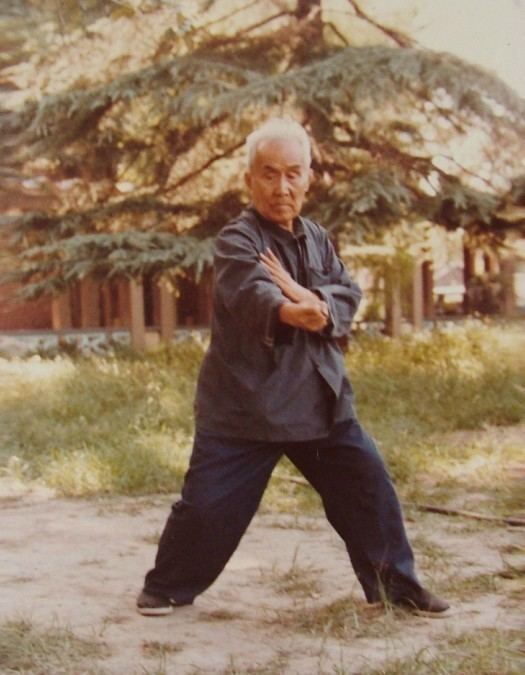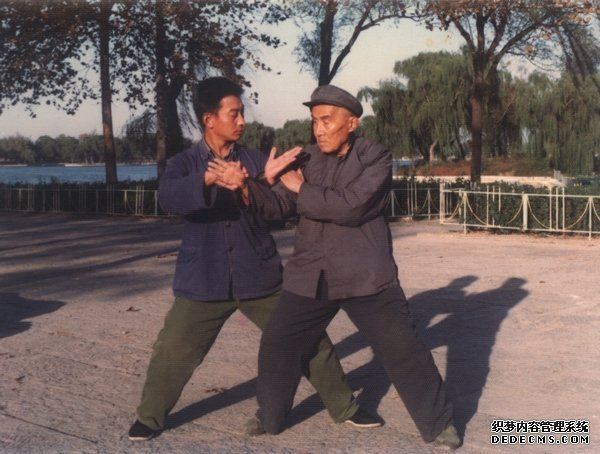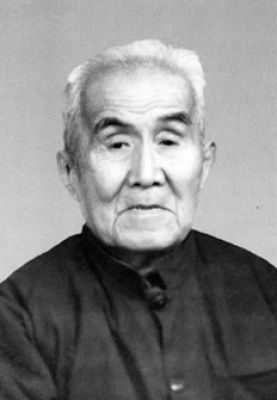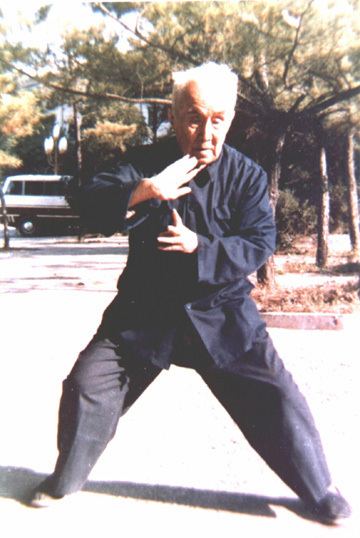Nationality Chinese Years active 1956-1996. | Name Hong Junsheng | |
 | ||
Style Taijiquan, Chen-style taijiquan Occupation Martial Arts Teacher, Author Notable students He Shugan, Meng Xianbin, Xu Guichen, Zhang Lianen, Liu Chengde, Li Enjiu, Li Chugong, Wang Zhongxian, Jiang Jiajun, Chen Zhonghua, Chen Sheng Yu | ||
Grandmaster hong junsheng chen style taijiquan practical method
Hong Junsheng (洪均生), born in 1907,Henan Province (河南省), China, was a Chinese martial arts practitioner, teacher and author. Hong was the longest serving disciple for the Chen-style t'ai chi ch'uan (陈式太极拳) master Chen Fake (陈发科, 1887–1957). Starting in 1930, Hong trained uninterrupted with Chen for fifteen years. In 1956, Hong moved to Jinan (济南), Shandong Province (山东省). There, he practiced and researched the meaning of Chen-style t'ai chi ch'uan. He expressed his own understanding of the ch'uan through his teachings and his writings. His theories and training principles are now known as the Practical Method for Chen-style t'ai chi ch'uan (陈式太极实用拳法). Through the turmoil of the Cultural Revolution, Hong maintained his dedication to the enrichment of his art. In the Era of Restructuring, Hong had trained a new generation of Chen Stylists and wrote several articles to illuminate the mysteries of Chen-style t'ai chi ch'uan. As China opened up to the international community, Hong was rediscovered as an important linkage to this ancient Chinese martial arts tradition. T'ai chi enthusiasts from all over the world would come to train with this remarkable man. Fame and fortune did not change Hong. He remains steadfast to the ideals of the Tao. Near the end of his life, old and in ill health, he would still maintain his daily t'ai chi training schedule and looked forward to doing Push hands with his students. In 1996, aged 90 (according to the Chinese calendar), Hong died. Hong is survived by his family, his dedicated disciples and the lasting legacy of his Practical Method.
Contents
- Grandmaster hong junsheng chen style taijiquan practical method
- Hong junsheng documentary
- Training with Chen Fake 1930 1956
- Preparing for the Tao under harsh conditions 1957 1975
- Recognition of the Practical Method 1976 1996
- An enduring legacy for Chen style tai chi chuan
- Tai chi chuan lineage tree with Chen style focus
- References

Hong junsheng documentary
Training with Chen Fake (1930 - 1956)

Hong Junsheng (洪均生) was born in 1907, Yuxian County (禹县), Henan Province (河南省). His grandfather was a government official in the Qing Court. At an early age, Hong's family moved to Beijing. Hong's family was affluent providing Hong with a leisurely life style and a classical Chinese education. When Hong was young, he was physically weak and often sick. By the time Hong was seventeen, Hong could no longer continue his education because of his illness. Still feeling weak and sick even after getting married at the age of 20, Hong decided to improve his health by becoming more physically active. He started by walking around the Beijing neighborhood. In 1930, Hong began to learn Wu-style t'ai chi ch'uan (吴式太极拳) from Liu Musan (刘慕三) to further improve his health. Liu, originally from Wuxi (无锡) in Jiangsu Province (江苏省), was the director of the Telegram Service Department at Beijing Telegram Bureau and a well regarded protégé of Wu Chien-ch'uan (吴鉴泉, 1870–1942). The t'ai chi ch'uan world was in flux, just as Hong started his training with Liu. Before 1930, the public recognized t'ai chi ch'uan being taught by the Yang family and the Wu family but the arrival of Chen Fake and his promotion of Chen-style t'ai chi ch'uan would radically change this public perception. Chen Fake had moved from Chen village to Beijing to openly teach his family style. In accordance with Chinese martial arts tradition, Chen accepted and won all challenges. Chen's feats and exploits were widely reported in the press. Liu decided to investigate the validity of those claims. Liu invited Chen for a demonstration of the form as well as some friendly push hand competition. Liu was impressed by Chen's ability and decided to lead his students including Hong to study Chen-style t'ai chi ch'uan. For the next fifteen years, Hong studied diligently under the careful guidance of Chen Fake. Initially, Chen lived with Hong because of Hong's affluence. This allowed Hong to closely observe the teachings of Chen. Over time, Hong's health improved and this provided added impetus for Hong to continue his t'ai chi ch'uan training. Even as his family responsibility increased with his six sons and his fortune declined, Hong continued to train closely with Chen. Just as Hong’s wealth wane, Chen’s reputation was rising. Chen invited Hong’s family to stay with him. These allowed Hong once again to receive detail instructions from Chen. Over a thirty-year period, Chen Fake taught several hundred students in Beijing. Of those hundreds, only a handful can considered themselves to be disciples (入门弟子), Hong was one of the earliest of those disciples and studied with Chen the closest and longest.

In 1944, Hong’s fortune continued to decline and he had to move from Beijing to Jinan, Shangdong Province (山东省). He would stay there for the rest of his life researching and practicing Chen-style t'ai chi ch'uan according to the teachings of Chen Fake. He would meet his master just one more time. In 1956, Hong was able to visit Beijing to train again with Chen Fake. Hong spent an intensive four months checking with his master on his interpretation and understanding of Chen style. At the end, Chen Fake told Hong that Hong's skill had reach a sufficient level and that Hong can now teach t'ai chi ch'uan. (陈发科: “你的功夫已经达到了我所期望的水平,回去后,你可以教拳了。”) Hong heeded his teacher's advice. When Hong returned to Jinan, he started to teach earnestly Chen-style t'ai chi ch'uan. Just a year later, in 1957, Chen Fake died. Hong was then one of the last links to the traditional Chinese martial arts as practiced in the previous century.
Preparing for the Tao under harsh conditions (1957 - 1975)

Hong’s fate was deeply affected by the social turmoil that surrounded him. No longer wealthy, unemployed and supporting a large family, Hong still persisted in his study of the Chuan. The tragedy of the Cultural Revolution (1966-1976) added to the hardship of Hong, persecuted for his bourgeois past, Hong was often left hungry, malnourished and struggled to provide for his family.

Despite those trying circumstances, Hong continued to teach his t'ai chi ch'uan. Slowly, he gathered a core group of dedicated students to experiment and test his understanding of Chen Style. In his spare time, he would write down his thoughts on this ancient art. His single minded devotion to the practice helped him to persevere under those trying circumstances.
Recognition of the Practical Method (1976 - 1996)
Hong’s situation improved in the Era of reconstruction. The Chinese government and society no longer shunned its cultural heritage. The public showed a renewal interest in t'ai chi ch'uan. Past martial arts masters can openly teach their art. The Chinese government even sponsored demonstrations and exhibition to reacquaint the public with the Chinese martial arts. Hong, in general, avoided the public spotlight. In the rare occasions that he made a public performance, the audience was treated to the Chen-style t'ai chi ch'uan inherited from Chen Fake. Though personally humble, Hong was proud of the achievements of his students. When the government once again sponsored push hand competitions, the team trained by his student Li Enjiu (李恩久) surprised the country with their remarkable results. First in provincial tournaments, then on the national stage, competitors from Jinan captured many gold medals. Their success can all be attributed to the teachings of Hong.
As the memories of the Cultural revolutions faded, China reestablished relations with other countries such as Japan. Japanese tourists were interested in the authentic martial arts heritage of China. Their exploration took them all over China including Chen Village and then to Jinan. Various Japanese martial arts associations discovered Hong training in his usual location near Black Tiger Spring(黑虎泉). They were impressed by his abilities through some impromptu test of skills. Those organizations started to organized regular tours to train with Hong and established t'ai chi clubs based on the teachings of Hong in Japan. His visitors gave him the nickname “The Super Star of Tai Chi Chuan” (太极巨星) and “Tai chi’s Magic Hand” (太极魔手) Eventually t'ai chi enthusiast from around the world will come to train with Hong. The Chinese government improved the living situation for Hong due to his increase popularity and demand from foreign visitors. Later, Hong was able to travel around the world to promote his understanding of Chen-style t'ai chi ch'uan.
In 1988, Hong finally compiled his twenty one years of written notes into one comprehensive book – Chen Tai Chi Practical Method (Chén shì tàijí quán shíyòng quánfǎ, 陈式太极拳实用拳法) In this book, Hong described every technique in the Chen-style t'ai chi ch'uan curriculum and tried to correct what he perceived as misinterpretations that is prevalent in t'ai chi ch'uan practice. Using his expertise in tradition Chinese Poetry, he captured the essence of Chen-style t'ai chi ch'uan in two poems that is known as the "Three-Character Canons (三字经)" and "The Quality of Tai Chi Chuan (太極拳品)". In 2006, portions of this book was translated into English by Hong’s disciple, Chen Zhonghua.
In 1990, Hong suffered a stroke which left him paralyzed from the waist down. Through shear will power, Hong was still able to practice his ch'uan even though he could no longer walk freely. This he attribute to his daily t'ai chi practice. He would continue to train with his students each day until his death in 1996.
An enduring legacy for Chen-style t'ai chi ch'uan
Hong’s legacy is his research and understanding of Chen-style t'ai chi ch'uan as taught by Chen Fake. This legacy can be seen in his disciples who are all well regarded t'ai chi ch'uan practitioners teaching Hong’s Practical Method. Amongst his multitude number of disciples include:
Hong’s understanding of Chen-style t'ai chi ch'uan can be summarized in the first verse of his poem "Three-Character Canons" (三字经):
which translates as:
In Chen-style t'ai chi, The theory is precise, Yin and yang is the principle, Both part of an interplay.
This revelation can be seen in the practice of the Practical Method of Chen Style Tai Chi Chuan according to the instructions of Hong Junsheng.
T'ai chi ch'uan lineage tree with Chen-style focus
Hong Junsheng can be seen as the 10 generation practitioner of Chen style t'ai chi ch'uan as shown on the Chen-style lineage tree. According to Hong, only direct descendants of the Chen family can considered themselves to be practitioners of Chen family t'ai chi ch'uan (陳家太極拳). All other Chen t'ai chi ch'uan practitioners are Chen stylists (陈式) as long as the principles unique to Chen style are observed. Some t'ai chi ch'uan practitioners refer to Hong's method as Hong style t'ai chi ch'uan (洪式太极拳), Hong himself never acknowledge such naming conventions. He always insisted that he was merely a student of Chen Fake and was teaching according to his teacher's instructions. Hong used the term "Practical Method" (实用拳法) to emphasize the martial aspects of his research and training.
